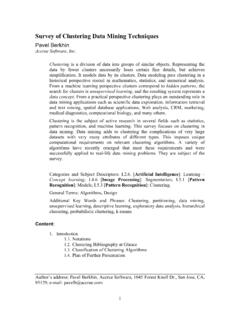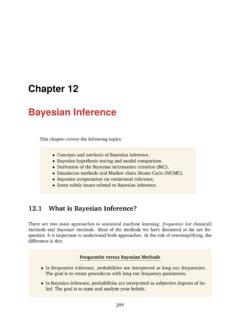Transcription of Sequential Pattern Mining - College of Computing
1 Sequential Pattern Mining 1. Outline What is sequence database and Sequential Pattern Mining Methods for Sequential Pattern Mining Constraint-based Sequential Pattern Mining Periodicity analysis for sequence data 2. Sequence Databases A sequence database consists of ordered elements or events Transaction databases vs. sequence databases A transaction database A sequence database TID itemsets SID sequences 10 a, b, d 10 <a(abc)(ac)d(cf)>. 20 a, c, d 20 <(ad)c(bc)(ae)>. 30 a, d, e 30 <(ef)(ab)(df)cb>. 40 b, e, f 40 <eg(af)cbc>. 3. Applications Applications of Sequential Pattern Mining Customer shopping sequences: First buy computer, then CD-ROM, and then digital camera, within 3 months.
2 Medical treatments, natural disasters ( , earthquakes), science & eng. processes, stocks and markets, etc. Telephone calling patterns , Weblog click streams DNA sequences and gene structures 4. Subsequence vs. super sequence A sequence is an ordered list of events, denoted < e1 e2 el >. Given two sequences =< a1 a2 an > and =<. b1 b2 bm >. is called a subsequence of , denoted as . , if there exist integers 1 j1 < j2 < < jn m such that a1 bj1, a2 bj2, , an bjn is a super sequence of . =< (ab), d> and =< (abc), (de)>. 5. What Is Sequential Pattern Mining ?
3 Given a set of sequences and support threshold, find the complete set of frequent subsequences A sequence : < (ef) (ab) (df) c b >. A sequence database SID sequence An element may contain a set of items. 10 <a(abc)(ac)d(cf)> Items within an element are unordered and we list them alphabetically. 20 <(ad)c(bc)(ae)>. 30 <(ef)(ab)(df)cb> <a(bc)dc> is a subsequence 40 <eg(af)cbc> of <a(abc)(ac)d(cf)>. Given support threshold min_sup =2, <(ab)c> is a Sequential Pattern 6. Challenges on Sequential Pattern Mining A huge number of possible Sequential patterns are hidden in databases A Mining algorithm should find the complete set of patterns , when possible, satisfying the minimum support (frequency) threshold be highly efficient, scalable, involving only a small number of database scans be able to incorporate various kinds of user- 7.
4 Specific constraints Studies on Sequential Pattern Mining Concept introduction and an initial Apriori-like algorithm Agrawal & Srikant. Mining Sequential patterns , [ICDE'95]. Apriori-based method: GSP (Generalized Sequential patterns : Srikant & Agrawal [EDBT'96]). Pattern -growth methods: FreeSpan & PrefixSpan (Han et '00;. Pei, et al. [ICDE'01]). Vertical format-based Mining : SPADE (Zaki [Machine Leanining'00]). Constraint-based Sequential Pattern Mining (SPIRIT: Garofalakis, Rastogi, Shim [VLDB'99]; Pei, Han, Wang [CIKM'02]). Mining closed Sequential patterns : CloSpan (Yan, Han & Afshar [SDM'03]).
5 8. Methods for Sequential Pattern Mining Apriori-based Approaches GSP. SPADE. Pattern -Growth-based Approaches FreeSpan PrefixSpan 9. The Apriori Property of Sequential patterns A basic property: Apriori (Agrawal & Sirkant'94). If a sequence S is not frequent, then none of the super-sequences of S is frequent , <hb> is infrequent so do <hab> and <(ah)b>. Seq. ID Sequence 10 <(bd)cb(ac)>. Given support threshold 20 <(bf)(ce)b(fg)>. min_sup =2. 30 <(ah)(bf)abf>. 40 <(be)(ce)d>. 50 <a(bd)bcb(ade)> 10. GSP Generalized Sequential Pattern Mining GSP (Generalized Sequential Pattern ) Mining algorithm Outline of the method Initially, every item in DB is a candidate of length-1.
6 For each level ( , sequences of length-k) do scan database to collect support count for each candidate sequence generate candidate length-(k+1) sequences from length-k frequent sequences using Apriori repeat until no frequent sequence or no candidate can be found Major strength: Candidate pruning by Apriori 11. Finding Length-1 Sequential patterns Initial candidates: <a>, <b>, <c>, <d>, <e>, <f>, <g>, <h> Cand Sup Scan database once, count support <a> 3. for candidates <b> 5. <c> 4. min_sup =2. <d> 3. Seq. ID Sequence 10 <(bd)cb(ac)> <e> 3. 20 <(bf)(ce)b(fg)> <f> 2.
7 30 <(ah)(bf)abf> <g> 1. 40 <(be)(ce)d>. 50 <a(bd)bcb(ade)>. <h> 1. 12. Generating Length-2 Candidates <a> <b> <c> <d> <e> <f>. <a> <aa> <ab> <ac> <ad> <ae> <af>. 51 length-2 <b> <ba> <bb> <bc> <bd> <be> <bf>. Candidates <c> <ca> <cb> <cc> <cd> <ce> <cf>. <d> <da> <db> <dc> <dd> <de> <df>. <e> <ea> <eb> <ec> <ed> <ee> <ef>. <f> <fa> <fb> <fc> <fd> <fe> <ff>. <a> <b> <c> <d> <e> <f> Without Apriori <a> <(ab)> <(ac)> <(ad)> <(ae)> <(af)>. property, <b> <(bc)> <(bd)> <(be)> <(bf)>. 8*8+8*7/2=92. <c> <(cd)> <(ce)> <(cf)>. <d> <(de)> <(df)>. candidates <e> <(ef)> Apriori prunes <f> candidates 13.
8 Finding Length-2 Sequential patterns Scan database one more time, collect support count for each length-2 candidate There are 19 length-2 candidates which pass the minimum support threshold They are length-2 Sequential patterns 14. The GSP Mining Process 5th scan: 1 cand. 1 length-5 seq. <(bd)cba> Cand. cannot pass pat. sup. threshold 4th scan: 8 cand. 6 length-4 seq. <abba> <(bd)bc> Cand. not in DB at all pat. 3rd scan: 46 cand. 19 length-3 seq. <abb> <aab> <aba> <baa> <bab> . pat. 20 cand. not in DB at all 2nd scan: 51 cand. 19 length-2 seq. pat.
9 10 cand. not in DB at all <aa> <ab> <af> <ba> <bb> <ff> <(ab)> <(ef)>. 1st scan: 8 cand. 6 length-1 seq. pat. <a> <b> <c> <d> <e> <f> <g> <h>. Seq. ID Sequence min_sup =2 10 <(bd)cb(ac)>. 20 <(bf)(ce)b(fg)>. 30 <(ah)(bf)abf>. 40 <(be)(ce)d>. 15. 50 <a(bd)bcb(ade)>. The GSP Algorithm Take sequences in form of <x> as length-1. candidates Scan database once, find F1, the set of length-1. Sequential patterns Let k=1; while Fk is not empty do Form Ck+1, the set of length-(k+1) candidates from Fk;. If Ck+1 is not empty, scan database once, find Fk+1, the set of length-(k+1) Sequential patterns Let k=k+1.
10 16. The GSP Algorithm Benefits from the Apriori pruning Reduces search space Bottlenecks Scans the database multiple times Generates a huge set of candidate sequences There is a need for more efficient Mining methods 17. The SPADE Algorithm SPADE ( Sequential Pattern Discovery using Equivalent Class) developed by Zaki 2001. A vertical format Sequential Pattern Mining method A sequence database is mapped to a large set of Item: <SID, EID>. Sequential Pattern Mining is performed by growing the subsequences ( patterns ) one item at a 18. time by Apriori candidate generation The SPADE Algorithm 19.













